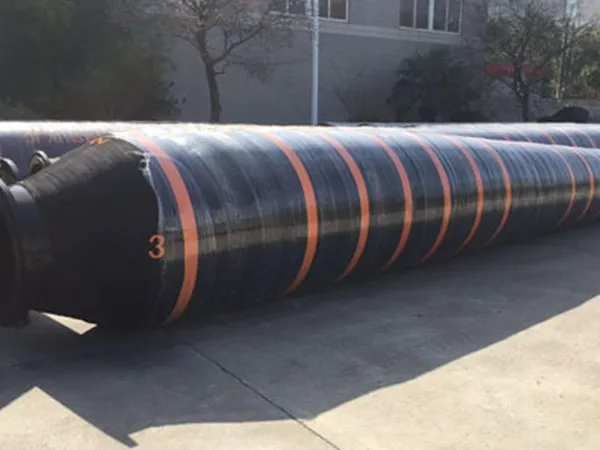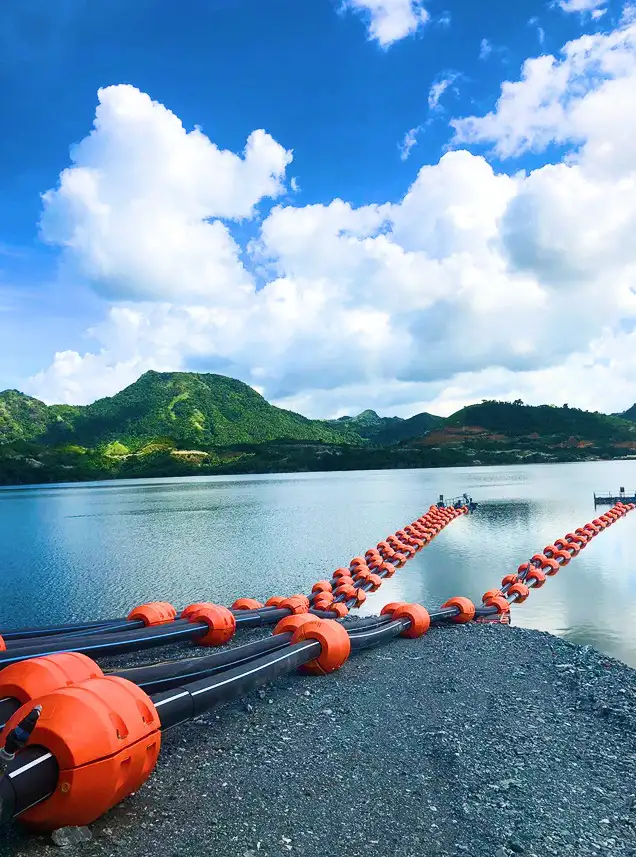
Dredging floating hoses are specialized flexible pipes designed for the transportation of slurry, sand, gravel, and other dredged materials between dredgers and discharge areas, particularly in marine, river, and offshore dredging operations. These hoses are engineered to float on water, ensuring efficient and continuous transfer of materials even in challenging environments.
A dredging floating hose is a specialized, heavy-duty pipeline designed to transport a mixture of water and dredged material (known as slurry) from a dredger to a designated discharge point. It is the critical, flexible link that makes modern hydraulic dredging possible, efficiently bridging the gap across water.
At its core, the floating hose is engineered to be both a durable conduit and a buoyant vessel, allowing it to float on the water's surface while withstanding the extreme pressures and abrasive forces of the dredging process.
The primary purpose of a dredging floating hose is to create a continuous, adaptable discharge line that can:
Follow the Dredger: As a dredger moves, the floating pipeline must flex and follow without interrupting the pumping operation.
Adapt to Water Conditions: The hose line easily adjusts to waves, tides, and currents, maintaining a stable and efficient transport path.
Avoid Seabed Obstacles: By floating on the surface, the pipeline avoids potential damage from underwater rocks, debris, or an uneven seabed.
Ensure Navigational Safety: A visible, floating pipeline is easier for other marine traffic to identify and avoid compared to a submerged line.
Without floating hoses, discharging dredged material over long distances across water would be impractical, inefficient, and significantly more complex.
A dredging floating hose is a multi-layered composite structure, with each layer serving a specific purpose.
Inner Lining: This is the most critical layer for durability. It is made from highly abrasion-resistant synthetic rubber (like NR/SBR) or polyurethane (PU). Its primary job is to withstand the constant scouring of sand, gravel, rock, and other abrasive solids in the slurry.
Reinforcement Layers: To handle high internal pressures and prevent kinking, the hose is reinforced with multiple layers of high-tensile synthetic tire cord. A steel wire helix is also embedded within these layers to provide structural rigidity and resistance to crushing and vacuum pressure.
Buoyancy Layer (The "Floating" Component): This is what distinguishes it from other industrial hoses. It consists of a thick layer of independent, closed-cell foam (typically PE foam). This foam provides the necessary buoyancy to keep the entire hose, filled with dense slurry, afloat. The closed-cell structure ensures that even if the outer cover is punctured, the hose will not absorb water and sink.
Outer Cover: The outermost layer is a protective shell made of a synthetic rubber compound. It is designed to resist environmental factors such as UV radiation, ozone, seawater corrosion, and physical impacts from waves or collisions. It is often brightly colored (e.g., orange) for high visibility.
Flanges/Fittings: Each end of the hose is fitted with built-in steel flanges. These allow individual hose sections to be securely bolted together to form a long, continuous pipeline. The flange design ensures a leak-proof seal capable of handling high pressures.
Buoyancy: Floating hoses incorporate either integrated foam layers or external flotation collars to ensure they remain buoyant, even when laden with dredged material. This prevents sagging and keeps the hose above water.
Durability and Abrasion Resistance: Given the abrasive nature of the materials they transport (sand, gravel, slurry), these hoses feature highly wear-resistant inner linings, often made from specialized rubber compounds.
Flexibility: They are designed to be flexible, allowing for movement with water currents, waves, and the shifting positions of dredging vessels. This flexibility also prevents kinks and collapse.
Reinforcement: To withstand high pressures and ensure durability, floating hoses are typically reinforced with multiple layers of materials like synthetic fibers (e.g., polyester cord, nylon cord) and steel wires.
Environmental Resistance: The outer cover is often made from rubber compounds that provide excellent resistance to weathering, UV radiation, and ozone.
Flanges: They are equipped with steel flanges at both ends for secure connection to other hose sections or pipelines.
While the basic construction is similar, hoses are specialized for different applications:
Standard Floating Hose: The most common type, used for transporting sand, mud, and silt.
Armored Floating Hose: Features an extra-thick or specially hardened inner lining for transporting highly abrasive materials like coarse gravel, rock, or coral.
Tapered or Enlarged End Hose: These hoses have one flange end with a larger diameter than the other. They are used to connect hose lines to the steel pipes on the dredger or at the discharge point, often reducing flow turbulence at the connection.
Self-Floating Hose: The standard design described above, with integrated buoyancy foam.
The construction of dredging floating hoses involves a combination of materials, typically including:
Rubber: Natural rubber is often used for the inner lining due to its wear resistance. Synthetic rubbers like BR and SBR may be blended in for enhanced performance. The outer cover is also rubber-based, formulated for weather and UV resistance.
Reinforcement Layers: High-strength synthetic fibers such as polyester cord or nylon cord are commonly used to provide structural integrity and withstand pressure.
Steel wires or spirals may also be incorporated for additional strength and kink resistance.
Foam/Flotation Material: Closed-cell foam (often polyethylene foam) is integrated into the hose structure to provide buoyancy and prevent water absorption.
Metal Components: Steel flanges and connectors are used for robust and secure connections.
Floating dredging hoses are vital in various marine and industrial applications, including:
Port and Harbor Maintenance: Removing sediment to maintain navigable waterways.
Land Reclamation: Transporting dredged material for creating new land.
Shoreline Restoration: Moving sand for beach nourishment projects.
Mining: Transferring abrasive slurries from floating barges or pumps to processing plants.
Offshore Oil and Gas: Used for transferring crude oil, refined fuels, or drilling fluids.
River Dredging: For maintaining river depths and managing sediment.
